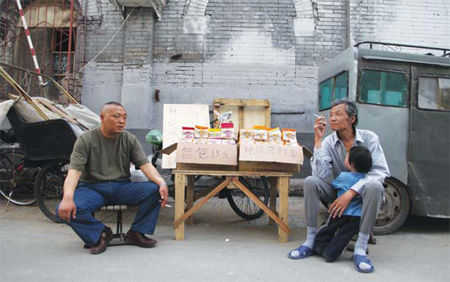Street fighters
Updated: 2010-12-17 10:35
By Liu Lu (China Daily European Weekly)
Despite this recent victory, some locals still lament the loss of Beijing's past.
"The Xizhimen skyway is now standing on the site of my elementary school," says 27-year-old Lisa He, an English high school teacher.
"It was surrounded by more than 30 hutong and has now turned into a busy transportation hub surrounded by high-rise buildings and fancy department stores."
"I think foreigners come here to see the authentic old Beijing customs, not another Hong Kong or New York."
But not all Beijingers share the same sentiment and are proud of the modernization push.
"I lived in a hutong all my life with my parents and we crammed ourselves into a 10-square-meter room," says Chu Daye, 28, a website editor.
"It was very noisy and it was hard to concentrate when I was studying.
"Now we live in a 60-sq-m apartment, which is much better.
"But we live near the Fifth Ring Road and the new location is inconvenient compared to the old one because it was in the center of the city."
|
|
Some heritage experts particularly fear the demolition of courtyard houses and a city facelift that would be irreversible. "Beijing is bent on building a modern 'world city', but it is unwise to meet the goal at the cost of cultural and historical destruction," says Tang Yuyang, a professor with the Beijing University of Civil Engineering and Architecture.
"Hutong are the soul of Beijing and their construction cannot be repeated."
She suggests Beijing learn heritage lessons from European cities, such as London, Paris and Rome, all international metropolises with long histories. "Paris has made a conservation plan covering the whole city, in which 80 percent of Paris is under historic preservation. Any construction must be 'blended into the old environment'," she says.
It appears city authorities are responding. They released a report on Nov 4, saying that no major construction projects are planned for Beijing's old city area, referring to the area within the city's Second Ring Road.
The Beijing Municipal Commission of Urban Planning has issued a series of plans for the protection of the old city area in September 2009, highlighting the protection of traditional courtyard houses.
These courtyard homes, or siheyuan, which had not yet been listed as cultural relics but had typical characteristics of the Ming (1368-1644) and Qing (1644-1911) dynasties courtyards, are now protected. "These policies are signs of government progress," Tang says. "It shows that the government has come to realize the value of old community culture and accepts the voices from the public."
But she says it is hard for protective measures to always keep up with the pace of city development, and the protection of hutong in Beijing's outer suburbs may be overlooked.
"There must be ways to balance protection and development," Tang says, "otherwise, it is only empty talk unless government puts those written resolutions into practice."
E-paper

Ear We Go
China and the world set to embrace the merciful, peaceful year of rabbit
Preview of the coming issue
Carrefour finds the going tough in China
Maid to Order
Specials

Mysteries written in blood
Historical records and Caucasian features of locals suggest link with Roman Empire.

Winning Charm
Coastal Yantai banks on little things that matter to grow

New rules to hit property market
The State Council launched a new round of measures to rein in property prices.

